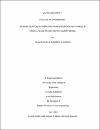| Abstract | In 2013, Qatar Rail announced major rail projects that include an urban rail network for the city of Doha with lines running on the surface and underground which are expected to be in operation by 2020. Railway systems are known as attractive means of transportation that can be implemented to solve traffic problems in urban areas. However, they are associated with noise and vibration that cause disturbance, not only to passengers, but also to occupants of nearby buildings. The purpose of this research is to contribute to the literature by developing an understanding on the dynamic tunnel-soil interaction and the propagation of waves in the ground. In this work, a Finite Element model has been developed that accounts for the specific details of tunnel and ground by a commercial FE software, Abaqus 6-14.
The software is used first to model a single isolated tunnel in 2D (plane strain) with point load (corresponding to line load for the 3D case). Then, the software is used to model 3D tunnel under a line load. The results for the 2D and 3D models were found to be matching each other as well as with results from other models reported in the literature. A 2D plane strain model is then developed for a tunnel embedded in a half space and a good agreement was observed when comparing the results with those reported in the literature.
Finally, the FE package was used to explore the effect of tunnel shape on the propagation of ground-borne vibration. Several FE models of circular, square, rectangular, and oval tunnels embedded in homogenous soil and multi-layered medium representing Qatar soil were created and analyzed. Changing the tunnel shapes have an influence on vibration measurement in y-direction at frequency higher than 50 Hz for a response point located on the ground surface. Under low frequency (1 Hz to 10 Hz), there is no such difference in vibration for a different twin tunnel shapes embedded in multi-layered soil at a response point located on the ground surface. In general, the numerical results revealed that twin tunnels influence the dynamic tunnel-soil interaction in homogenous and multi-layered soil medium. |


